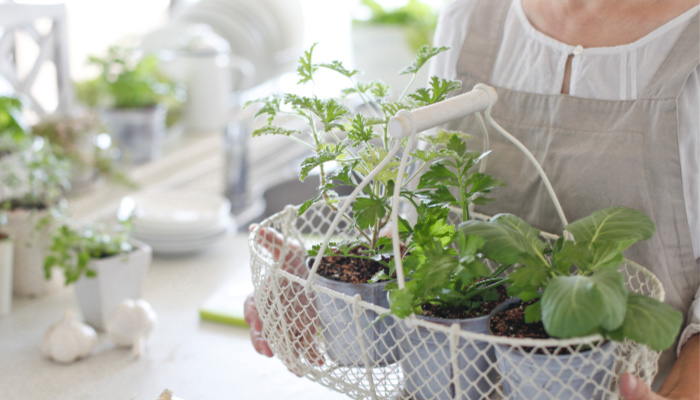Shutterstock

We’re all trying to be a little more green. Sometimes that means hitting up the local farmers market instead of the chain grocery store. But what if you could get even more local than that? It’s not only possible but surprisingly easy to grow vegetables indoors.
In order to successfully grow vegetables indoors, you’ll need a few things. A spot that gets at least 6 hours of sunlight a day is essential; you can supplement that light in the winter with full-spectrum fluorescents. You’ll need the right growing medium for your plants—regular garden soil won’t cut it. Your indoor garden can’t get too dry or too moist, and you should choose a place that has good air circulation and a controlled temperature.
Some plants are simple enough to grow in a sunny window, while others will require a more elaborate setup. If you’re really serious about maintaining a year-round food garden, even in the winter, you can make it work. However, it’s best to start small and simple with greens and herbs before tackling more challenging plants like tomatoes or strawberries.
Herbs: You’re probably already familiar with the idea of growing potted herbs like basil or mint. Rosemary, mint, and cilantro will also thrive indoors. Herbs are often easiest to buy as mature plants from a nursery instead of growing from seed.
Carrots: You can totally grow carrots indoors! Crazy, right? Pick a smaller variety in a long, narrow container, such as a window box. You can sow the seeds directly in moist potting mix and cover with a thin layer of damp peat moss. Within 2 weeks, you should have sprouts!
Lettuce: Most lettuces grow ridiculously fast and don’t need too much space. You can even harvest the outer leaves while the plant continues to grow, making for the freshest salad you’ve ever eaten. Lettuce can grow in as little as 2-4 inches of soil, making it a great choice for small indoor vegetable gardens.
Scallions: Scallions are one of those veggies you only need occasionally and in small batches. The good news is that they thrive indoors on relatively low levels of sunlight. You can simply snip off as much of the greens as you need, and the rest will keep growing.
Microgreens: These trendy-but-tasty sprouts are amazing on salads, in sandwiches, or even in smoothies. You can plant a seed blend of kale, beet, and arugula greens and enjoy crunchy sprouts within about two weeks. Since you’re harvesting seedlings instead of mature plants, microgreens don’t need nearly as much space as other indoor veggies.
Potatoes: If you’ve ever accidentally left a potato too long in a cupboard, you’re aware that those suckers will grow roots if you let them. You can grow potato plants in hanging pouches instead of pots or buckets, maximizing your use of space.